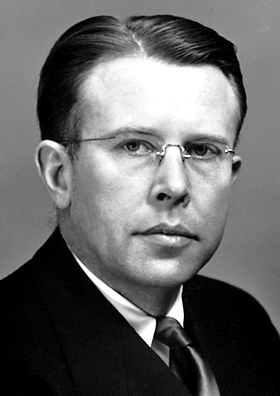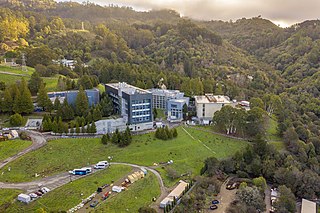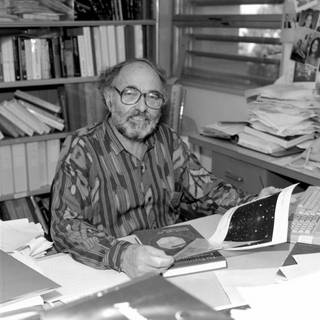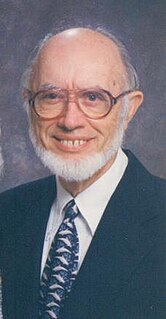
Glenn Theodore Seaborg was an American chemist whose involvement in the synthesis, discovery and investigation of ten transuranium elements earned him a share of the 1951 Nobel Prize in Chemistry. His work in this area also led to his development of the actinide concept and the arrangement of the actinide series in the periodic table of the elements.
Lawrence Livermore National Laboratory (LLNL) is a federal research facility in Livermore, California, United States, founded by the University of California, Berkeley in 1952. Originally a branch of the Lawrence Berkeley National Laboratory, the Lawrence Livermore laboratory became autonomous in 1971 and was designated a national laboratory in 1981.

Ernest Orlando Lawrence was an American nuclear physicist and winner of the Nobel Prize in Physics in 1939 for his invention of the cyclotron. He is known for his work on uranium-isotope separation for the Manhattan Project, as well as for founding the Lawrence Berkeley National Laboratory and the Lawrence Livermore National Laboratory.

Lawrence Berkeley National Laboratory (LBNL), commonly referred to as Berkeley Lab, is a United States national laboratory that is owned by, and conducts scientific research on behalf of, the United States Department of Energy. Located in the hills of Berkeley, California, the lab overlooks the campus of the University of California, Berkeley, and is managed by the University of California system.

Edwin Mattison McMillan was an American physicist credited with being the first-ever to produce a transuranium element, neptunium. For this, he shared the 1951 Nobel Prize in Chemistry with Glenn Seaborg.

Melvin Ellis Calvin was an American biochemist known for discovering the Calvin cycle along with Andrew Benson and James Bassham, for which he was awarded the 1961 Nobel Prize in Chemistry. He spent most of his five-decade career at the University of California, Berkeley.

Emilio Gino Segrè was an Italian-American physicist and Nobel laureate, who discovered the elements technetium and astatine, and the antiproton, a subatomic antiparticle, for which he was awarded the Nobel Prize in Physics in 1959 along with Owen Chamberlain.

Owen Chamberlain was an American physicist who shared with Emilio Segrè the Nobel Prize in Physics for the discovery of the antiproton, a sub-atomic antiparticle.

Saul Perlmutter is a U.S. astrophysicist at the Lawrence Berkeley National Laboratory and a professor of physics at the University of California, Berkeley. He is a member of both the American Academy of Arts & Sciences and the American Philosophical Society, and was elected a Fellow of the American Association for the Advancement of Science in 2003. He is also a member of the National Academy of Sciences. Perlmutter shared the 2006 Shaw Prize in Astronomy, the 2011 Nobel Prize in Physics, and the 2015 Breakthrough Prize in Fundamental Physics with Brian P. Schmidt and Adam Riess for providing evidence that the expansion of the universe is accelerating. Since 2021, he has been a member of the President’s Council of Advisors on Science and Technology (PCAST).
Mina J. Bissell is an Iranian-American biologist known for her research on breast cancer. In particular, she has studied the effects of a cell's microenvironment, including its extracellular matrix, on tissue function.
The Supernova Cosmology Project is one of two research teams that determined the likelihood of an accelerating universe and therefore a positive cosmological constant, using data from the redshift of Type Ia supernovae. The project is headed by Saul Perlmutter at Lawrence Berkeley National Laboratory, with members from Australia, Chile, France, Portugal, Spain, Sweden, the United Kingdom, and the United States.

Darleane Christian Hoffman is an American nuclear chemist who was among the researchers who confirmed the existence of Seaborgium, element 106. She is a faculty senior scientist in the Nuclear Science Division of Lawrence Berkeley National Laboratory and a professor in the graduate school at UC Berkeley. In acknowledgment of her many achievements, Discover Magazine recognized her in 2002 as one of the 50 most important women in science.

George Fitzgerald Smoot III is an American astrophysicist, cosmologist, Nobel laureate, and the 2nd contestant to win the $1 million prize on Are You Smarter than a 5th Grader?. He won the Nobel Prize in Physics in 2006 for his work on the Cosmic Background Explorer with John C. Mather that led to the "discovery of the black body form and anisotropy of the cosmic microwave background radiation".

Gerson Goldhaber was a German-born American particle physicist and astrophysicist. He was one of the discoverers of the J/ψ meson which confirmed the existence of the charm quark. He worked at Lawrence Berkeley National Laboratory with the Supernova Cosmology Project, and was a professor of physics at the University of California, Berkeley as well as a professor at Berkeley's graduate school in astrophysics.

Frank Asaro was an Emeritus Senior Scientist at the Lawrence Berkeley National Laboratory associated with the University of California at Berkeley. He is best known as the chemist who discovered the iridium anomaly in the Cretaceous–Paleogene boundary layer that led the team of Luis Alvarez, Walter Alvarez, Frank Asaro, and Helen Michel to propose the Asteroid-Impact Theory, which postulates that an asteroid hit the Earth sixty-five million years ago and caused mass extinction during the age of the dinosaurs.
Elizabeth A. Rauscher (1937-2019) was an American physicist and parapsychologist. She was born in Berkeley, California on March 18, 1937. She died on July 3, 2019.
Isadore Perlman was an American nuclear chemist noted for his research of Alpha particle decay. The National Academy of Sciences called Perlman "a world leader on the systematics of alpha decay". He was also recognized for his research of nuclear structure of the heavy elements. He was also noted for his isolation of Curium, as well as for fission of tantalum, bismuth, lead, thallium and platinum. Perlman discovered uses of radioactive iodine and phosphorus for medical purposes. He played a key role in Manhattan Project's plutonium production.

Katherine "Kathy" Anne Yelick is an American computer scientist, a professor of Electrical Engineering and Computer Sciences at the University of California, Berkeley, and the Associate Laboratory Director for Computing Sciences at Lawrence Berkeley National Laboratory.

Charles Vernon (Chuck) Shank is an American physicist, best known as the director of the Lawrence Berkeley National Laboratory from 1989 to 2004.

Dawn Angela Shaughnessy is an American radiochemist and principal investigator of the heavy element group at the Lawrence Livermore National Laboratory. She was involved in the discovery of five superheavy elements with atomic numbers 114 to 118.














